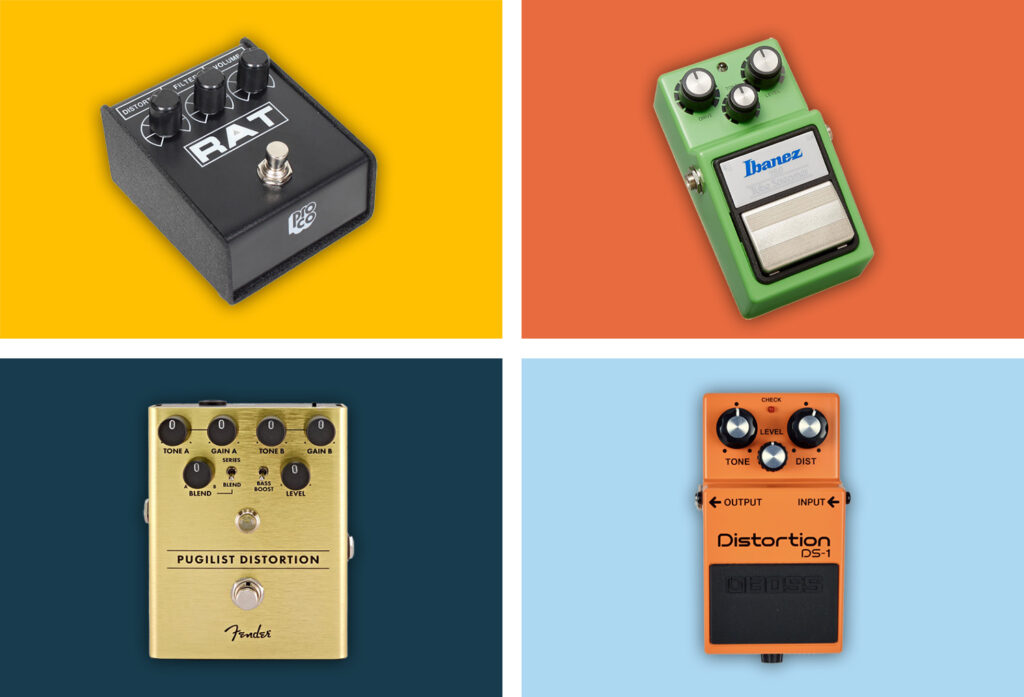It's hard to imagine an electric guitar without distortion - that's clear. But how do you get real distortion without having an all-tube amp and cranking it all the way?
Quite simply, with a distortion pedal. These pedals are designed to distort the sound of an electric guitar, usually without tubes, but with DSP (Digital Signal Processing) or analog circuits. They are connected between the electric guitar and the guitar amplifier and can be switched on and off with a footswitch.
Their sound has gotten so good that many of them sound almost as good as all-tube amps. And compared to the all-tube monsters, they offer many other advantages, such as portability, the ability to save presets, or the ability to produce strong distortion at low volume.
There is a wide variety of pedals out there, with many from well-known manufacturers like Boss, Behringer, and MXR that have been bestsellers for years. However, with new models coming out every year, it can sometimes be difficult to choose. This guide will help you find the best distortion pedal for your needs.
In a nutshell: Which distortion pedal is best?
In our opinion, the best distortion pedals at the moment are the ProCo Rat 2, because it has made a huge contribution to rock history, and the Fender Pugilist, because it offers an enormous variety of sounds that are not possible with other pedals.
The Ibanez TS9 Tubescreamer and the Warm Audio Centavo Klon Centaur are the best options for overdriving an amp's signal.
For a really dirty, distorted sound with long sustain à la Jimi Hendrix, the Electro Harmonic Big Muff is your best bet.
The best distortion pedals
ProCo Rat 2 Distortion / Overdrive Pedal
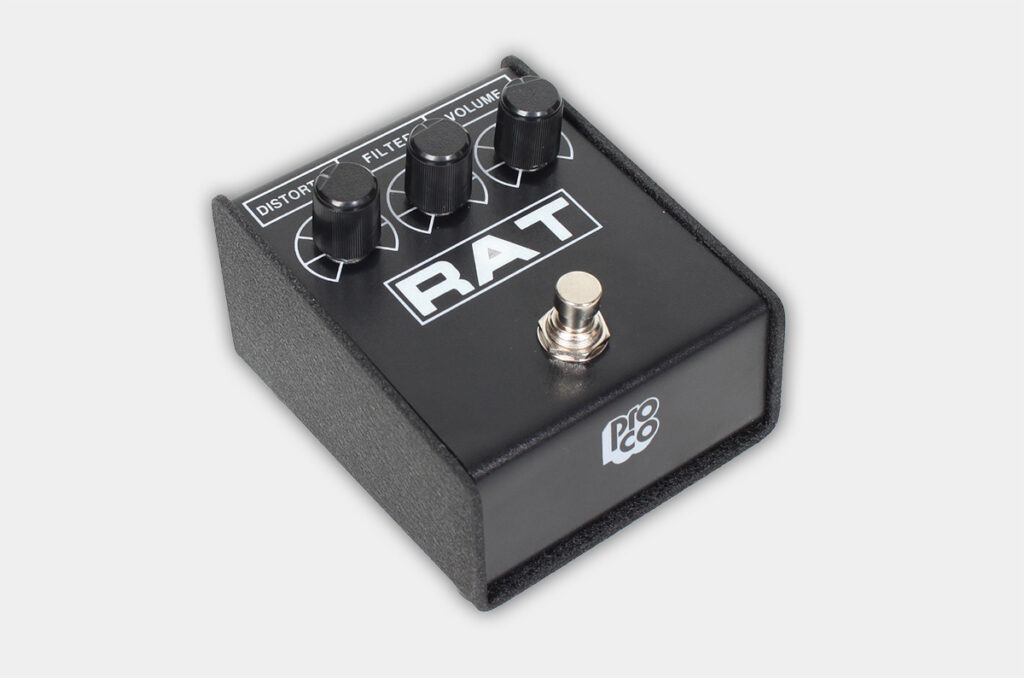
SPECIFICATIONS
Parameters: Distortion, Filter, Volume
Bypass: True Bypass
Analog/digital: Analog
LINK
ARGUMENTS IN FAVOR
- Legendary sound
- Very versatile (overdrive, distortion, and even fuzz)
- Very good price/performance ratio
NEGATIVE POINTS
- –
This distortion pedal is the most legendary on this list and has made a huge contribution to rock history. When it was introduced in 1978, it was one of the first distortion pedals ever. It has stood the test of time and is still one of the best, if not the best, distortion pedals ever made. It can be heard on many recordings from the last 46 years!
The pedal itself is quite simple: It just has knobs for distortion (how much the signal is distorted), filter (to make the sound brighter or darker), and volume (to control the overall volume). But you can basically use it to create all kinds of sounds.
The sonic palette ranges from slight overdrive with the distortion control turned up just a bit to very heavy distortion with the control turned all the way up. And to be honest, the sound is in no way inferior to an all-tube amp!
The pedal has only one input and output, a footswitch to turn the pedal on and off, and a power input. The pedal can be powered by either a 9V power supply or a 9V battery.
But what I find incredible is the price, because this pedal costs only €93. That's very reasonable for a pedal that's been on the market for over 40 years and is still one of the best sellers. That's why I think it's the best distortion pedal ever.
Fender Pugilist Distortion Pedal
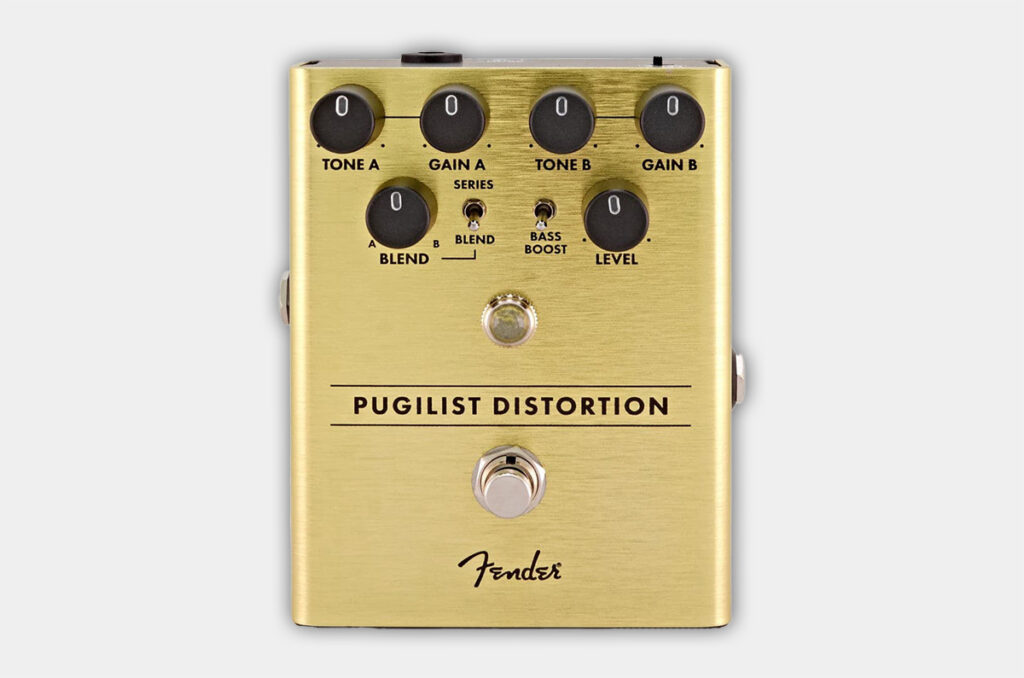
SPECIFICATIONS
Parameters: Tone A, Gain A, Tone B, Gain B, Blend/Series switch, A/B Blend, Level, Bass Boost
Bypass: True Bypass
Analog/digital: Analog
LINK
ARGUMENTS IN FAVOR
- Many possibilities for sound design
- Great sound
- The price is incredibly affordable for the amount of functionality
NEGATIVE POINTS
- It can take some time to find the perfect sound
The Fender Puiglist is a very innovative pedal: it offers two separate "channels" of distortion that can be combined to create endless possibilities for sound shaping. Fender has decided not to copy other pedals like many other manufacturers, but to think completely new.
As mentioned earlier, there are two separate channels (A and B), each with a gain control (for distortion) and a tone control (for sound). Channel B can distort more than channel A. The two channels can then be combined using the blend control, or they can be connected in series by setting the switch to "Series" instead of "Blend".
The overall volume can be adjusted with the level control, and there is an additional switch for bass boost. As the name suggests, this boosts the low frequencies. Each control has a built-in LED light to indicate its position in the dark (these LEDs can also be turned off with a switch on the back).
This distortion pedal is capable of producing all degrees of distortion, from slight boost to moderate overdrive to heavier distortion, which is ideal for hard rock or metal. You can even create a slight fuzz distortion by cranking both gain controls to the extreme.
In my opinion, this pedal offers the most features and although it is less than 40 years old, the quality of Fender has been proven in over 70 years of guitar and amp building. So I can really recommend it to anyone.
Keep reading: The 11 best electric guitars for beginners
Boss DS-1 Distortion Pedal
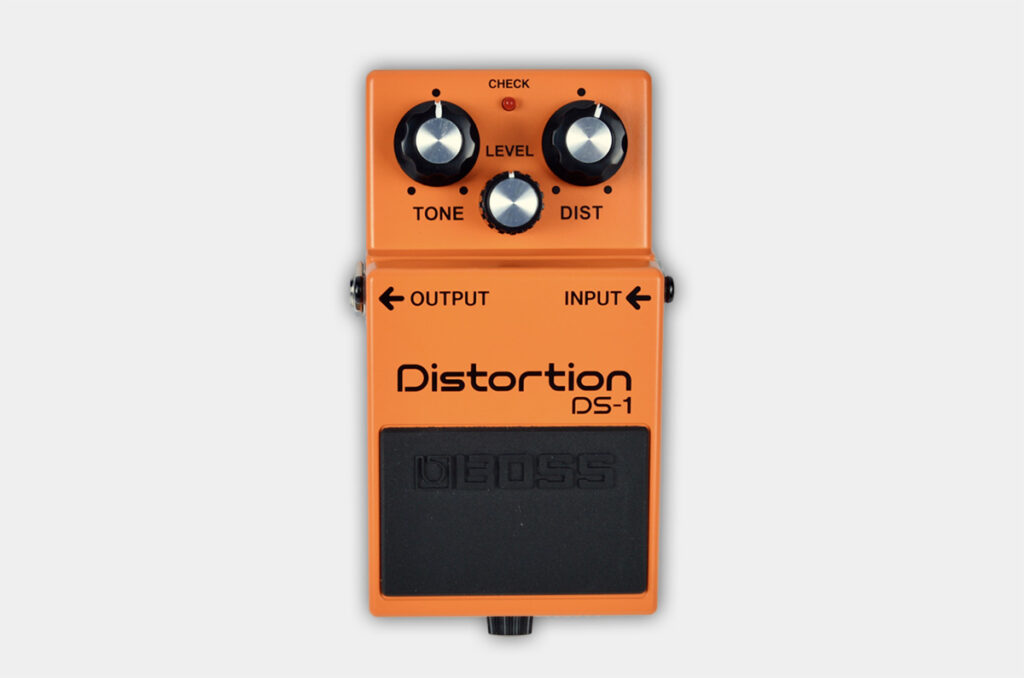
SPECIFICATIONS
Parameters: Tone, Distortion, Level (Master)
Bypass: True Bypass
Analog/digital: Analog
LINK
Boss DS-1 Distortion Pedal (76€)
Boss DS-1w Distortion (143€)
ARGUMENTS IN FAVOR
- Easy to operate
- Beautiful, familiar distortion
- Good price
NEGATIVE POINTS
- Not as versatile as other models
Another classic distortion pedal is the Boss DS-1, which was also introduced in 1978 and has been one of the most popular pedals ever since. It has been used by legends like Kurt Cobain and Joe Satriani.
This pedal also has a relatively simple design and is very similar to the ProCo Rat - there are only 3 controls for distortion, volume and tone. The latter controls the tone color (dark or bright). The distortion tends towards a British sound and can range from very soft (more like overdrive) to harder distortion sounds that can easily compete with more expensive full-tube amps.
The Tone control is very useful - it can really crank up the treble to make the guitar cut through any mix, or it can make the sound very dark, which is perfect for rhythm riffs.
Nevertheless, the electric guitar sounds relatively natural - there are very nice overtones that make the distortion sound very harmonious and musical. The dynamics are also not bad for a distortion sound, as the signal is not overly compressed.
In addition to the original version, there is also the Boss DS-1w, which can distort even more if you turn the distortion knob all the way up. Otherwise it sounds exactly like the original.
MXR 75 Super Badass Distortion
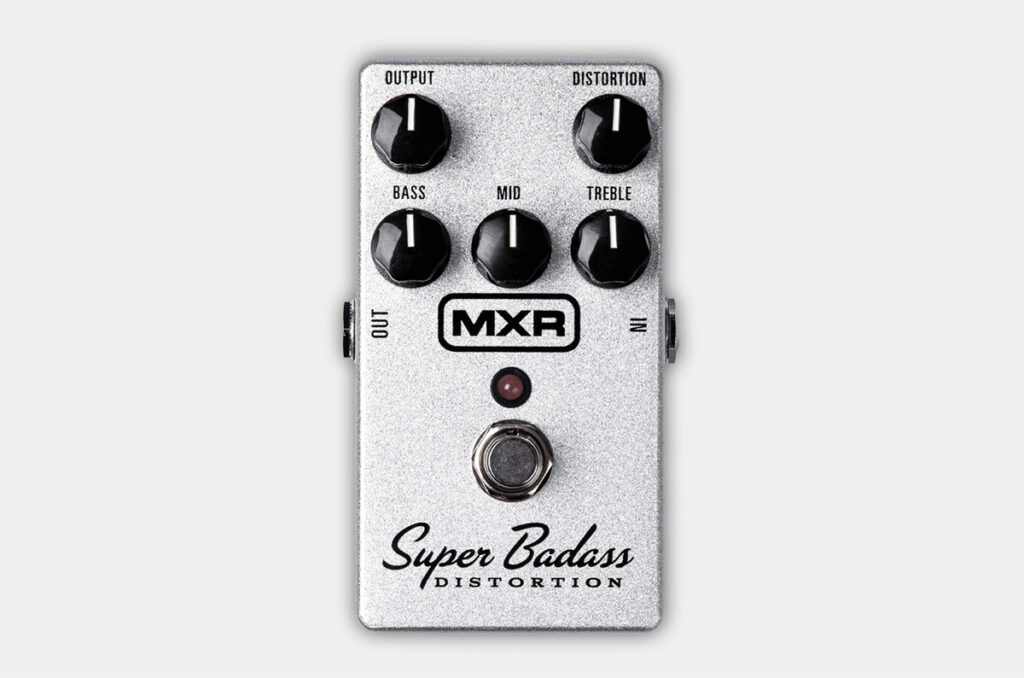
SPECIFICATIONS
Parameters: Bass, Mid, Treble, Distortion, Output (Master)
Bypass: True Bypass
Analog/digital: Analog
LINK
ARGUMENTS IN FAVOR
- 3-band EQ allows for many tonal colors
- Wide range of distortions possible
- Very nice distortion
NEGATIVE POINTS
- More expensive than other models
The MXR 75 is a very versatile distortion pedal, because in addition to the distortion and volume controls, it also features a 3-band EQ to shape the sound. This is very useful because you can use it to boost the highs and lows for a great metal sound, or cut them and boost the mids for a more bluesy sound.
The 3-band EQ gives you a lot of sonic options. The distortion control is also very smooth: turn it up just a little and you get a smooth distortion that is very moderate. Perfect for blues or relatively clean genres.
Turning the knob up further gives you a considerable amount of distortion that can range from rock to metal to punk. From about 3/4 of the way up, it gets extremely distorted and muddy (fuzz distortion) and you start to hear a lot of noise. This only happens when really overdriven, though.
This pedal is 100% analog, so there is no DSP technology, just analog circuitry. It distorts by clipping the signal through an internal amplifier.
Boss SD-1 Super Overdrive
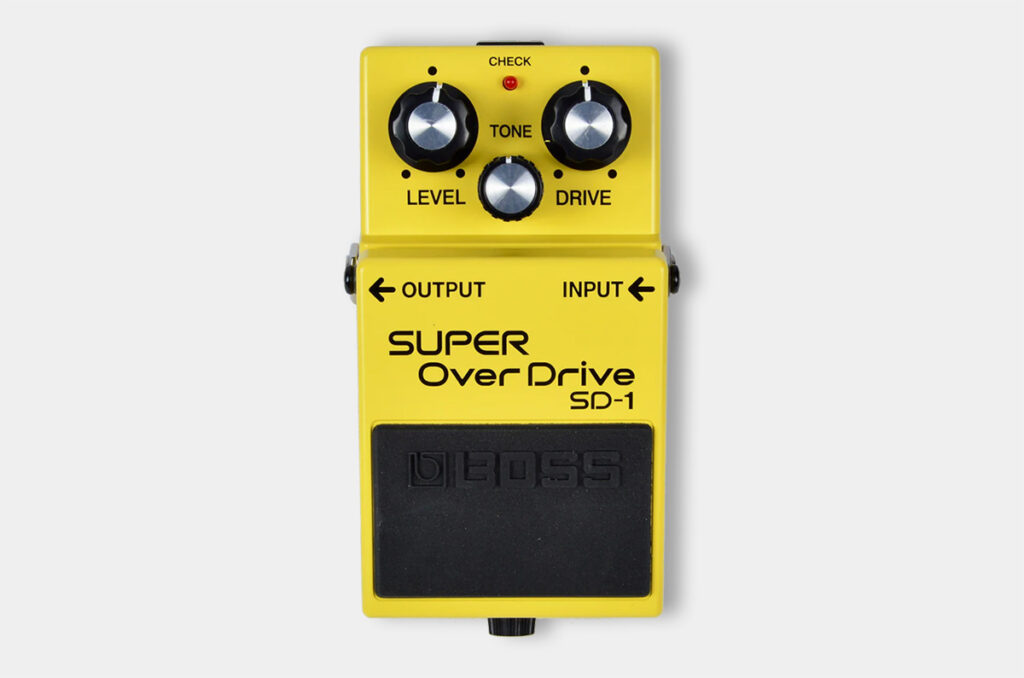
SPECIFICATIONS
Parameters: Level, Tone, Drive
Bypass: True Bypass
Analog/digital: Analog
LINK
ARGUMENTS IN FAVOR
- Very good price
- Nice, light distortion, ideal for blues
NEGATIVE POINTS
- Not as versatile as other models
The Boss SD-1 is an overdrive pedal, so it can only distort a little, not a lot. But it can do it very well! But don't expect to get a metal sound from a clean amp with this pedal, because that's not possible.
What you can do very well with this pedal are crunch sounds or slightly distorted guitar sounds. If you control the distortion through the amp, this pedal can distort the signal a bit more. It gives the amp a little push that can work wonders in certain situations.
It has the same three controls as most distortion pedals: Volume, Distortion, and Tone. Turning up the Distortion control a bit gives you the typical booster sound, i.e. the signal gets louder, but hardly distorted and gets nice overtones. This allows any soloist to stand out in clean genres.
Turning up the distortion control further gives you the typical overdrive sound that is great for blues and rock. The sound then has a lot of overtones, but remains dynamic and harmonious.
This pedal can also be used in combination with other pedals - for example, you can use a Boss DS-1 behind the SD-1 to create really hard and distorted sounds.
TC Electronic Tube Pilot Overdrive
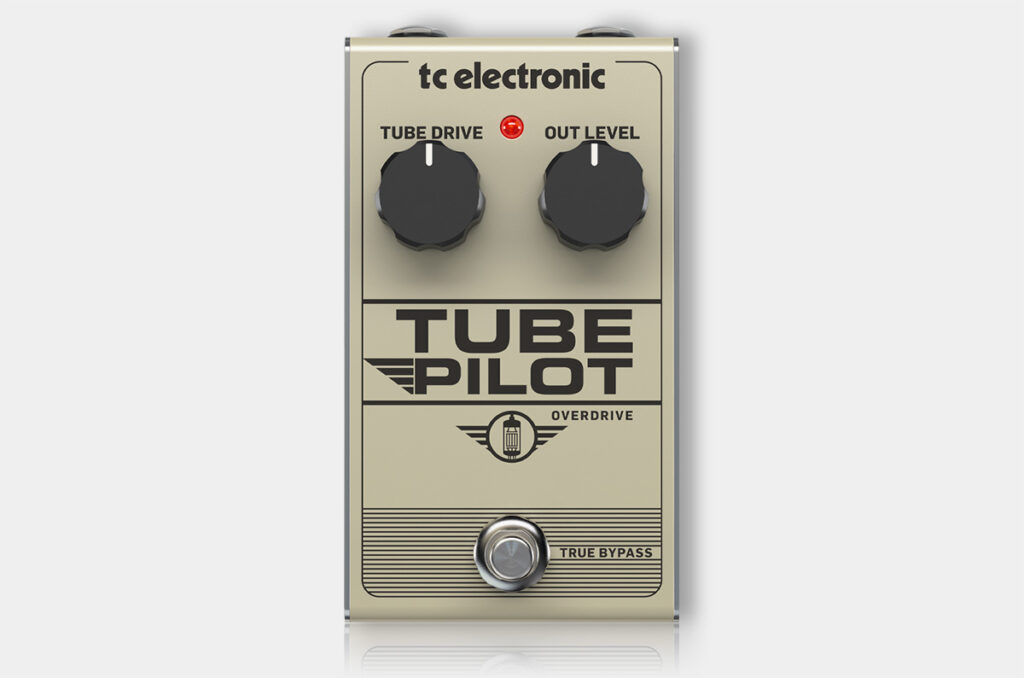
SPECIFICATIONS
Parameters: Drive, Output
Bypass: True Bypass
Analog/digital: Analog
LINK
ARGUMENTS IN FAVOR
- Perfect for light signal saturation
- Very smooth tube distortion
- Unbeatable price
NEGATIVE POINTS
- No tone control
Now we come to the first distortion pedal in this comparison that uses a real tube. The Tube Pilot Overdrive from TC Electronic is a simple but very powerful overdrive pedal that uses a 12AX7 tube to create distortion, just like in a tube amp.
It does not distort extremely - this is an overdrive pedal, not a distortion pedal - but it adds a lot of warmth and overtones to the sound. Perfect for adding some life to the transistor sound of your amp, for example, or for creating warm crunch sounds. But this pedal also sounds very nice and warm when used clean - it has that typical tube character.
But this is not a pedal for metal or anything like that, you need a distortion pedal for that. The pedal also only has two controls - one for the distortion and one for the volume. A tone control would have been nice, but you can't expect that for 58€. If you want to shape the sound a bit more, you can simply use the amp's EQ.
This pedal also works great with other pedals - for example, you can follow it with a hard distortion pedal to get the best of both worlds: a warm tube sound and extreme distortion.
Warm Audio - Centavo Klon Centaur
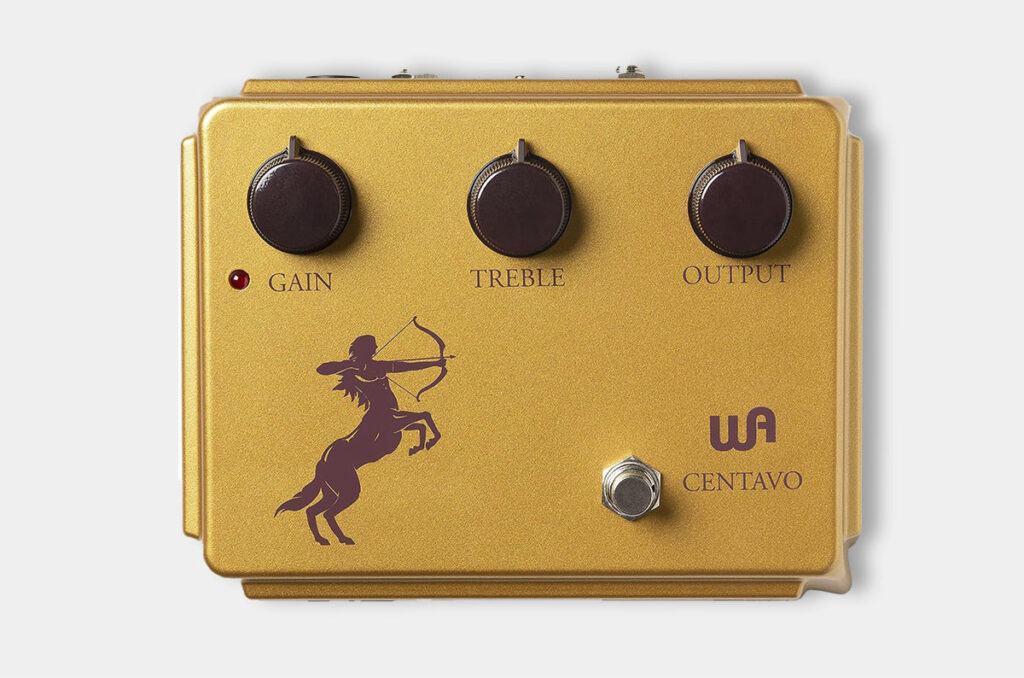
SPECIFICATIONS
Parameters: Gain, Treble, Output
Bypass: Buffered
Analog/digital: Analog
LINK
Warm Audio Centavo Overdrive (179€)
ARGUMENTS IN FAVOR
- Very faithful replica of the legendary pedal
- Very nice sound
NEGATIVE POINTS
- Expensive compared to other pedals on this list
This Warm Audio distortion pedal, like most of the brand's products, is a clone of a legendary distortion pedal from the 90s, the Klon Centaur. Only 8,000 of these pedals were made and the sound was so good that everyone wanted one. Because of the limited edition, 90s models are now selling for over €5,000 used.
But Warm Audio has released this clone and offers it for much less money, only 179€. And the sound is almost identical to the original. This pedal was so popular because it had the ability to distort the signal in a very clean and transparent way. The tone color of the guitar was changed only minimally, although a lot of gain was added. Not many pedals can do that.
The fact that this pedal adds so little coloration to the signal makes it extremely versatile - it can be used with all kinds of guitar models and amps. An Ibanez Tube Screamer, for example, boosts the mids a lot - so it works great with a Fender Stratocaster and a Fender amp, because that combination produces weak mids. But with many other amps, the Ibanez will not sound as good because the mids will be overemphasized.
This is exactly what doesn't happen with the Centavo: the sound is very transparent - there is no over-emphasis in any frequency range. As a result, the pedal sounds good with almost all amplifiers and electric guitars.
It's important to remember that this is an overdrive pedal, not a distortion pedal. So it won't distort as much as, say, the Boss DS-1, but that's not what it's for - the Warm Audio clone Centaur is more of a booster pedal.
Ibanez TS9 Tubescreamer distortion pedal
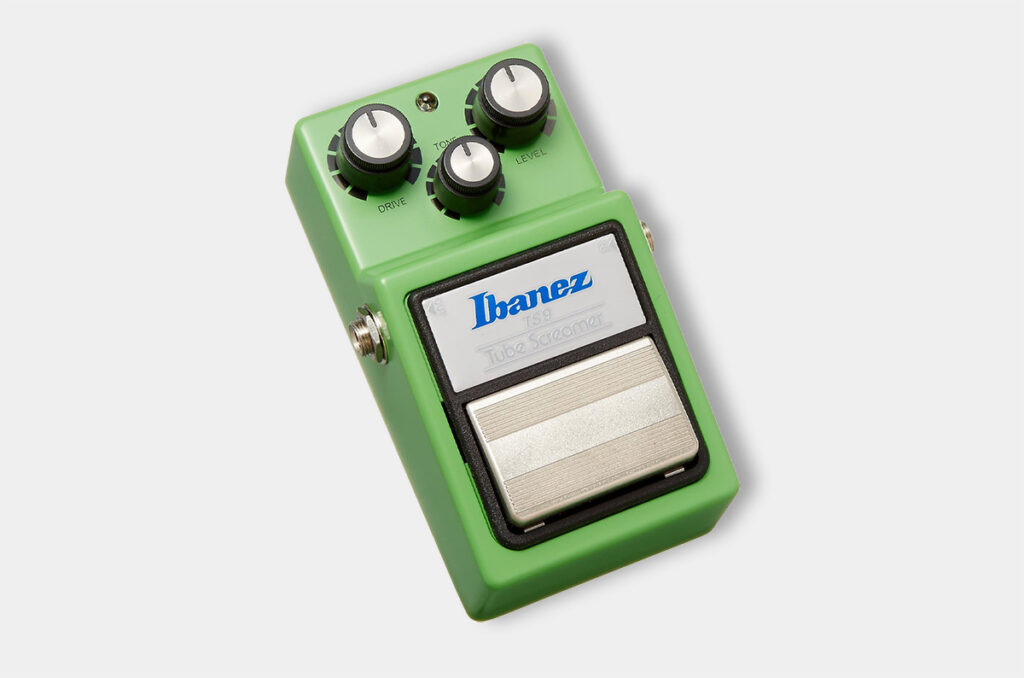
SPECIFICATIONS
Parameters: Drive, Tone, Level
Bypass: Buffered
Analog/digital: Analog
LINK
Ibanez TS9 Tubescreamer (148€)
ARGUMENTS IN FAVOR
- Legendary sound
- Sturdy hardware
- Especially suitable for Fender Stratocasters
NEGATIVE POINTS
- –
Here we have another classic - probably the most popular distortion pedal of all time. The Ibanez TS9 was introduced in 1979 (its predecessor was called the 808) and has been one of the most popular pedals ever since. There have been many clones and copies over the past 45 years, but none are as popular as the original. And that is after 45 years!
The pedal became especially popular thanks to Stevie Ray Vaughan, who often used it. But many other famous guitarists like John Petrucci and Keith Richards have also used the Ibanez TS9 to create distorted sounds.
The name Tube Screamer refers to the pedal's ability to overdrive the preamp section of a tube amp, resulting in more gain from the amp itself. This can result in a very distorted sound if the amp is also turned up.
With clean amps, the pedal produces more of an overdriven (i.e. slightly distorted) sound, while retaining a lot of dynamics and extending the sustain of the note. The Tube Screamer cannot produce metal sounds by itself, but it can with the right amp.
The pedal emphasizes the midrange of an electric guitar, making the sound come through beautifully in the mix. This is why it is so popular with the Fender Stratocaster + Fender amp combo, as this combination is a bit weak in the midrange.
Electro Harmonix Bigmuff
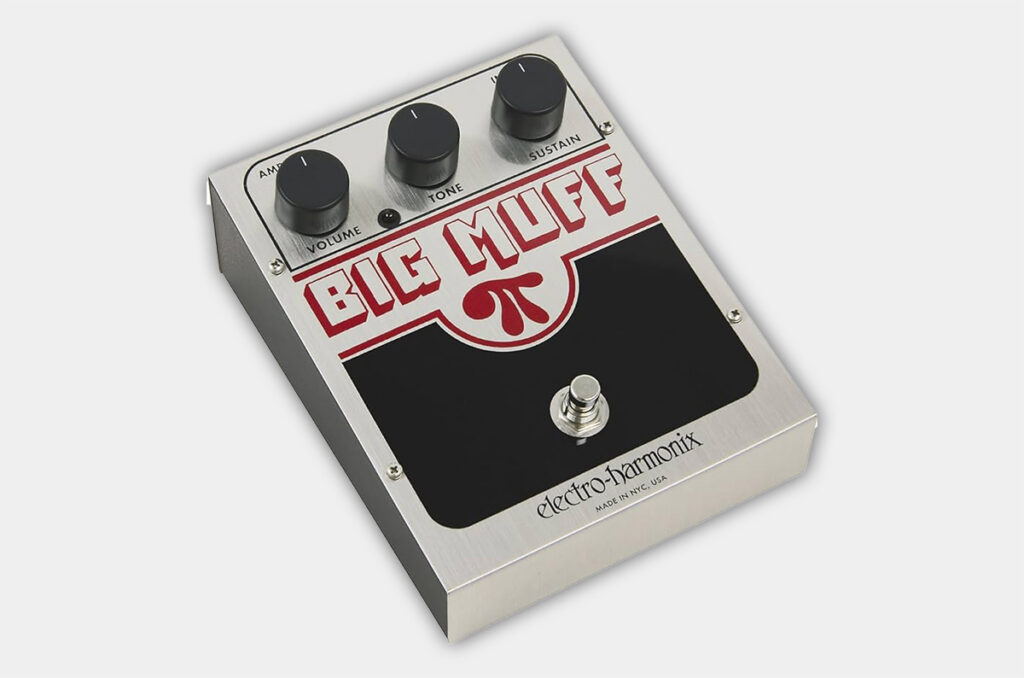
SPECIFICATIONS
Parameters: Volume, Tone, Sustain
Bypass: True Bypass
Analog/digital: Analog
ARGUMENTS IN FAVOR
- Great hard rock guitar sounds
- Very long sustains in the style of Jimi Hendrix possible
- Stays relatively clear even with hard distortion
NEGATIVE POINTS
- Not very versatile
The Electro Harmonix Bigmuff is the first fuzz pedal on this list because it produces extreme distortion. The so-called fuzz distortion sounds extremely compressed and the tones have a very long sustain, which you can also adjust individually with the sustain control on this pedal.
The pedal produces a sound reminiscent of heavy metal or punk, especially when the sustain is turned up very high. With moderate sustain and distortion, the electric guitar sounds more like Jimi Hendrix or Santana, and the sound is surprisingly good.
It sounds "dirty", but not "muddy" like other fuzz pedals - the tones sound surprisingly clear and differentiated. Feedback in the style of Jimi Hendrix can also be produced very well with this distortion pedal, especially when you turn up the sustain.
I can recommend this pedal to any guitarist who plays particularly hard genres - because you can create really powerful sounds even without a tube amp and for less than 100€. One thing you need to know about this pedal is that it is very large - pictures without a scale are often misleading. You will need a lot of space on your pedalboard.
Behringer VT999
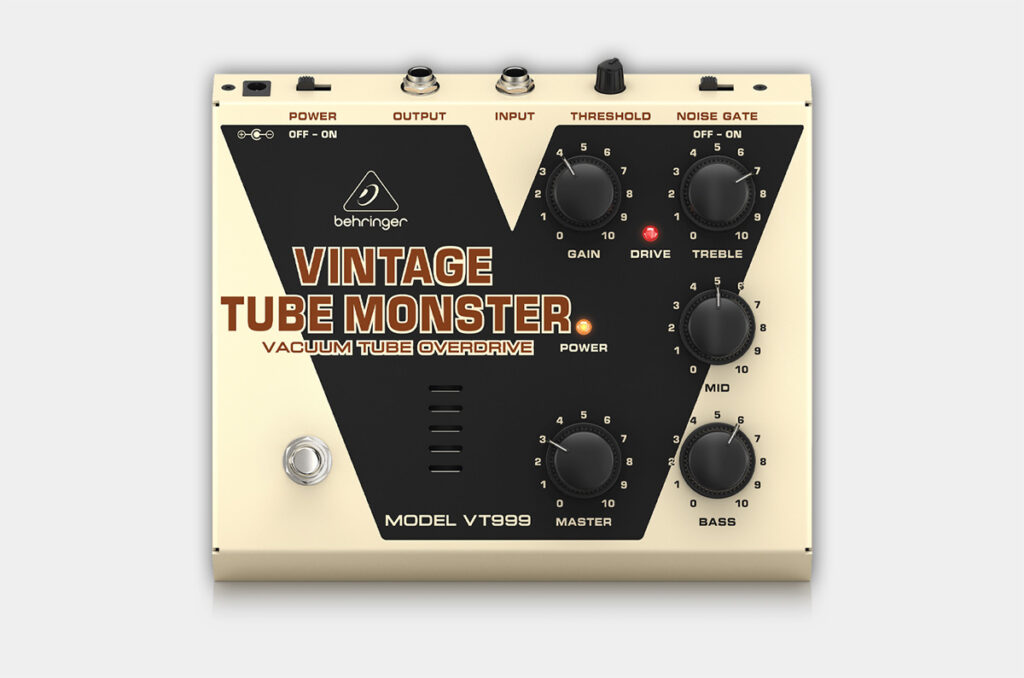
SPECIFICATIONS
Parameters: Gain, master, treble, mid, bass, noise gate switch, threshold
Bypass: Buffered
Analog/digital: Analog
LINK
Behringer VT999 (95€)
ARGUMENTS IN FAVOR
- Beautiful harmonic distortion
- Many options for customising the sound
- Very versatile (from overdrive to fuzz)
- Noise gate is a great feature to suppress noise
NEGATIVE POINTS
- Very large
The Behringer VT999 is a special distortion pedal with a 12AX7 tube and a switchable noise gate. It has a distortion control (Gain), a volume control (Master) and a 3-band EQ, which opens up a lot of tonal possibilities. The spectrum ranges from light blues distortion to hard heavy metal distortion.
The Noise Gate is used to suppress background noise during pauses in your playing, a common problem with distortion pedals. The Threshold control is used to adjust the volume at which the Noise Gate begins to operate.
Thanks to the built-in tube, the sound is very warm and has a vintage flavor. The dynamics are very well preserved and the compression is not too strong. The 3-band EQ is really good and very practical, allowing everything from dark to bright.
The pedal is very large, but quite sturdy. The price of €95 seems extremely cheap for the amount of features - but this is a Behringer product, and Behringer is known for making relatively good and very affordable equipment, as they produce in large quantities.
Marshall The Guv'nor
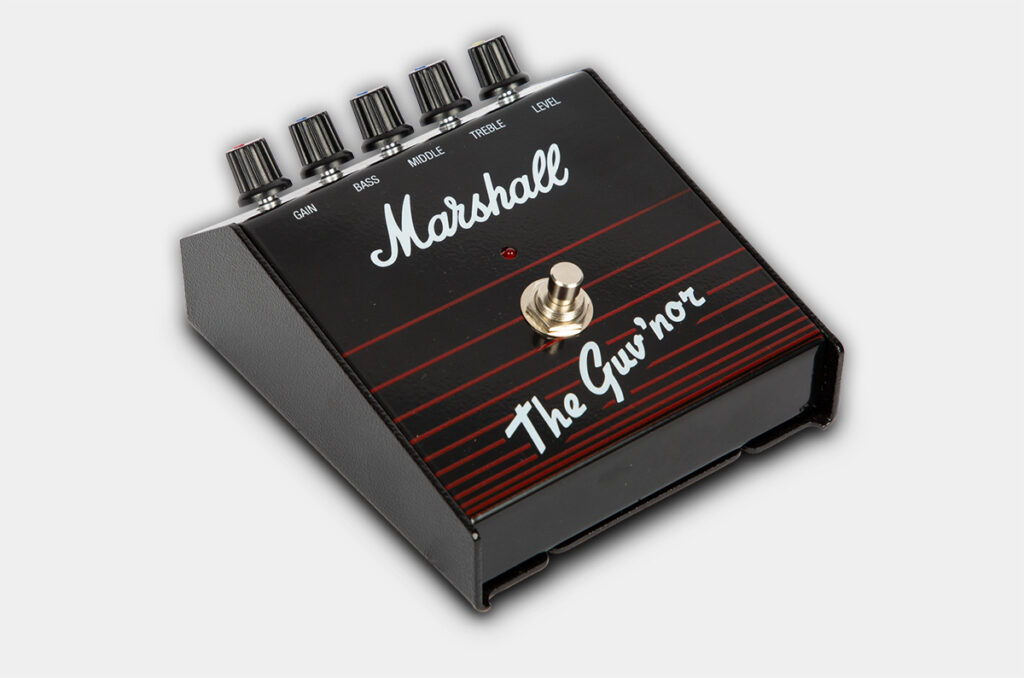
SPECIFICATIONS
Parameters: Gain, Treble, Mid, Bass, Level
Bypass: Buffered
Analog/digital: Analog
LINK
Marshall The Guv'nor (159€)
ARGUMENTS IN FAVOR
- One of the best distortions - no need for a tube amp with this pedal
- Versatile tonal range
- 3-band EQ allows for many tonal colors
NEGATIVE POINTS
- –
A legendary Marshall pedal that came out in 1988 and turned the world of distortion pedals upside down. The Marshall The Guv'nor was the first pedal that could really produce distortion that could compete with all-tube amps. Until then, distortion pedals had been used as boosters for recording - the distortion came from the amp.
As a result, you can use this pedal with clean amps and still get incredibly good distortion. The pedal has a 3-band EQ that allows you to distort the sound in all possible directions. There is also a gain and volume control.
This distortion pedal is based on analog circuitry (similar to the MXR 75), so it sounds dynamic and harmonic. At 159 Euros, it's more expensive than most of the pedals on this list, but it's worth every penny.
Overdrive, distortion, booster, fuzzer - what's the difference?
Categorizing distortion pedals can be a bit confusing, as there are several subcategories within distortion pedals. Overdrive, distortion, boost, or fuzz are all terms that describe distortion, although at different levels of intensity. Basically, the names only describe the intensity of the distortion.
Booster pedals
The Booster is the weakest form of distortion - it increases the volume of the guitar signal without significantly changing the sound. A few overtones may be added, but basically the listener will not perceive the sound of the electric guitar as distorted as AC/DC or Metallica. The sound is more like Eric Clapton.
These pedals are often used in relatively "clean" genres such as blues or jazz, where the electric guitar is playing a solo to stand out from the other instruments. The sound remains clean.
Overdrive pedals
The next level of distortion is overdrive. Here, the sound of the electric guitar is distorted even more, resulting in a distinct change in sound. Any listener would recognize the sound as a distorted electric guitar. As the name suggests, an overdrive pedal simulates the sound of an overdriven guitar amplifier.
A lot of overtones are added, and the sustain of the notes becomes longer, as you know from distorted sounds. The guitar sounds warmer and dirtier.
Overdrive pedals produce a sound reminiscent of AC/DC - definitely distorted and rocky, but not as distorted as metal bands like Metallica or Iron Maiden.
Distortion pedals
The next level of distortion is called Overdrive, and this is where it gets really hot! Here the sound is distorted even more and therefore sounds much "dirtier". The sustain of the notes is extended enormously and there is a strong natural compression, so the sound has almost no dynamics. If you hold the notes for a long time with the distortion on, it can even lead to the famous feedback (as with Jimi Hendrix when he brought his electric guitar closer to the amplifier).
The distortion sound is very popular with metal and hard rock bands. The sound is reminiscent of Metallica, Rammstein, Slipknot or Iron Maiden. Although the electric guitar sounds very distorted, we still find this sound natural.
Fuzz pedals
Fuzz pedals create an extreme form of distortion by severely overdriving the guitar signal and producing a very dense, almost synthetic distortion. The sound is rather unnatural compared to distortion. The name comes from the fact that a fuzz pedal was used to imitate the sound of broken equipment.
The signal is extremely compressed and has no dynamics. The sound is very dirty and somewhat random. Fuzz pedals are not as popular as the other 3 distortion pedals because they cannot be used as often. However, they are very popular in the punk genre.
Related articles:





